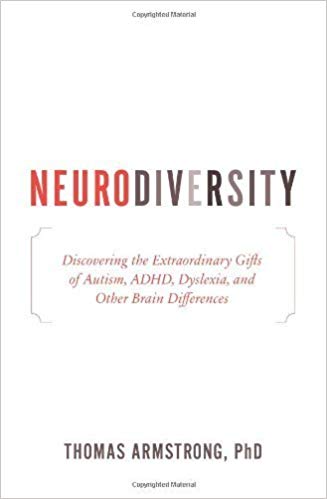Thomas Armstrong knows more than most about the strengths of people with “labeled” brain weaknesses. His book, “Neurodiversity”, is an insightful work that offers a balanced and colorful portrait of the groups described. While many have said similar things, none have satisfied and stimulated my interest as much as this book. With love for humankind, therefore, I want to introduce him to a wider audience and encourage his broader influence. I will summarize his general points in the hope that the reader will find them profitable and go on to read his book.
Spectrum of Abilities vs a Deficits Approach
Armstrong begins by describing his approach to individual education plans (IEPs): he takes the provided documentation (test scores, teacher notes, disciplinary reports, etc) and highlights mentions of the student’s strengths. He compiles these notes, often producing a two or three page summary from over 100 pages of largely negative documentation, and presents them as the keystone of a plan for the student. Without denying the challenges involved with the “labeled” weaknesses for the individual and their caretakers, he believes equal or greater attention should be centered on strengths as weaknesses.
The theoretical framework for this approach is the neurodiversity paradigm. A definition cited by him from Wikipedia defines it as “an idea that asserts that atypical (neurodivergent) neurological development is a normal human difference that is to be tolerated and respected as any other human difference.” So, rather than posing a neurological norm against which each person is graded, as the medical model does, neurodiversity sees each person, “disabled” or not, as being somewhere on the spectrum of human ability, possessing both strengths and weaknesses. This approach seeks to embrace the whole of humanity without sorting them into categories of able and unable.
Armstrong’s 8 Principles
At the heart of the work are his eight principles of neurodiversity. I will list them here with a summary of what each means:
#1: The Human Brain Works More Like an Ecosystem than a Machine – Instead of picturing the brain as a machine that is expected to perform consistently from person to person, he sees each as a unique ecosystem which adapts as needed to thrive.
#2: Human Beings and Human Brains Exist Along Continuums of Competence – Instead of a sharp dichotomy between ability and disability, he describes all people as being on a continuum of ability in every area of life.
#3: Human Competence Is Defined by the Values of the Culture to Which You Belong – He lists historical examples as divergent as runaway slaves and homosexuality to show how the values of a culture are expressed when they define what is acceptable and unacceptable to them.
#4: Whether You Are Regarded As Disabled or Gifted Depends Largely on When and Where You Were Born – Building on #3, he points out that the same behaviors or abilities are viewed differently, even oppositely, by different cultures. The label of “disabled” is assigned by culture.
#5: Success in Life Is Based on Adapting One’s Brain to the Needs of the Surrounding Environment – The arena for success and failure in life is, more or less, the culture in which one lives. Those who diverge from cultural norms often struggle to succeed for their non-conformity.
#6: Success in Life Also Depends on Modifying Your Surrounding Environment to Fit the Needs of Your Unique Brain (Niche Construction) – In a hopeful twist, he makes an analogy between “products of nature” like beaver dams and bird nests and ways in which neurodiverse individuals can construct “niches” in which they can live and thrive.
#7: Niche Construction Includes Career and Lifestyle Choices, Assistive Technologies, Human Resources, and Other Life-Enhancing Strategies Tailored to the Specific Needs of a Neurodiverse Individual – There are many ways in which a properly constructed “niche” can mitigate brain weaknesses.
#8: Positive Niche Construction Directly Modifies the Brain, Which in Turn Enhances Its Ability to Adapt to the Environment – Success builds on success, even extending to the actual connections within the “plastic” brain.
7 “Brain Deficits”
Armstrong says that each of the 7 conditions he discusses are labeled and thought deficient in America because they each violate a value of American society. These values are self-mastery (ADHD), sociability (autism), literacy (dyslexia), happiness (depression), tranquility (anxiety), intelligence (developmental disabilities), and rationality (schizophrenia). These brain weaknesses cause real frustration when trying to fit onto the path toward success laid out by our society because the compensating strengths often possessed alongside of them are rarely acknowledged and developed. The proverbial square peg fails again and again to fit the round hole until it sees itself as a defective round peg instead of a different kind of peg.
Diverse Intelligences
In the neurodiversity concept, emphasis is laid upon the concept of multiple intelligences (visual-spatial, linguistic-verbal, interpersonal, intrapersonal, logical-mathematical, musical, bodily-kinesthetic, and naturalistic) as opposed to a unitary, numerical concept (such as IQ) which does not measure or reflect the diverse kinds of intelligence there are. This allows the full range of human talents to be better acknowledged and developed, instead of just the traditional verbal-logical-mathematical “smarts” that have imperiously reigned for so long.
The Neurodiverse World
In the end, to be consistent with the neurodiversity paradigm, Armstrong says we must deny that the world is split between the neurodiverse and neurotypical. Even if we wish to analyze and know where we fall on the various spectra of ability, we ought not to say that the medium or some range between the extremes is How To Be (Human). No matter where each falls on the different measures, they belong to an infinitely varied human family. There is really just one world, a (neuro)diverse world. Go get this book and read it to learn more. Link to Amazon ebook.
